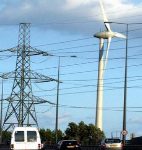The Danish Commission on Climate Change Policy’s report (see part one to read its vision for a low-carbon Denmark) has been generally well received by the political parties represented in Denmark’s parliament, as well as by industry and local governments. At the opening of parliament in October 2010, the prime minister announced that it was now the government’s goal to make Denmark independent of fossil fuels by 2050. The opposition parties are also generally supportive.
In February 2011, the government presented a proposal of initiatives to begin the transition to independence from fossil fuels including concrete goals for a reduction of fossil fuels in the energy system in 2020. An election was held before this proposal was negotiated in place, but the new government has retained the previous government’s 2050 vision and announced even more ambitious goals for the short-term, i.e.: 50% of electricity from wind in 2020 and complete removal of fossil fuels from the electricity and energy sectors by 2035.
But how can Denmark make this transition? The commission concludes that the key for making the country independent of fossil fuels lies in increasing wind turbine capacity, mainly offshore. The commission estimates that, in 2050, Denmark will require megawatt capacity between 11,000 (in the case of inexpensive biomass imports) and 18,500 (under the ambitious scenario and when biomass use is limited to Denmark’s own potential for production). By comparison, Denmark had in 2008 a wind turbine capacity of about 3,150 megawatts. Wind may come to represent around 45% of the gross energy supply in Denmark.
Biomass and waste will also be important in Denmark’s future energy production. The commission estimates that, in the ambitious world scenario, these sources will supply about 34% of the energy supply in 2050. In the unambitious scenario, biomass and waste may comprise about 72% of the energy supply.
The commission estimates that, in 2050, 44% to 63% percent of the energy used to heat buildings and for district heating will come from electric heat pumps that use heat from earth, water or air. A number of cities that employ district heating are found in regions with geothermal resources, however, often at too low a temperature to be used directly, thus needing a heat pump boost. Finally, large solar installations are expected to be able to competitively deliver heat for district heating. All together, heat pumps, geothermal sources, and solar heat are estimated to provide approximately 23% of Denmark’s future energy needs in the ambitious world scenario.
Photovoltaics and wave energy are technologies that are not competitive at the present time and it is unknown if or when these technologies will be able to compete with other renewable energies. On that basis, the models used by the commission do not see these technologies as playing an important role in the energy system in 2050. Nevertheless, that situation may change over time. Thus, it is important not to take the commission’s results as a prognosis of the energy system’s composition in 2050. The commission’s analyses show, however, that it would be possible and economically feasible to become independent of fossil fuels using technologies available today.
The commission argues that the use of economic instruments will be crucial in reaching the goal of fossil fuel independence. A gradual phasing in of a tax on the use of fossil fuels is a key instrument for the gradual phasing out of fossil fuel consumption. Energy infrastructure is relatively long lived. Thus, it is important to provide incentives not to invest in new fossil-fuel infrastructure. Therefore, one of the commission’s most important recommendations is that the government should establish long-term framework conditions, including the recommended increase in fossil-fuel taxes. This would provide a disincentive to invest in new fossil fuel infrastructure and, at the same time, encourage energy efficiency improvements.
The commission identified several mechanisms to ensure a match between the fluctuating electricity supply and demand in 2050:
1. Biomass, biogas, and waste provide a back-up when fluctuating sources like wind cannot deliver.
2. Intelligence can be built into the system so that electricity can be used or stored when it is generated for those energy services where it is feasible and cost effective.
3. International electricity transmission capacity to and from Denmark can be increased in order to exploit the synergy between Danish wind power and energy production in the rest of the region, including hydropower production in other Nordic countries.
4. The potential economic gain with increased electricity trade across country borders will, in many cases, be able to justify the establishment of the increased transmission capacity.
District heating cogeneration plants using biomass will also be able to provide some electricity production in periods where there is a need for extra production. In addition, “quick start” power production facilities (based on biomass or biogas) will be necessary to ensure that the electricity demand can be met at all times. These facilities should have a large production capacity (over 6,000 megawatts) but are only expected to run a limited number of hours per year.
In terms of transportation, the most likely alternatives to petrol and diesel for transport energy are electricity and biofuels. Biofuels are commercially available, but with a number of drawbacks, including modest CO2 reduction and energy losses in conversion in inefficient combustion engines. Electric vehicles, on the other hand, have not yet been developed to the point of offering a competitive alternative to conventional cars, mainly due to problems with sufficient energy storage (batteries) on board and slow recharging.
In addition, the development and widespread implementation of electric vehicles requires a not yet developed intelligent charging infrastructure. Plug-in-hybrids offer a possibility to replace part of the petrol or diesel consumption without sacrificing the flexibility of conventional cars, but both plug-in-hybrids and fully electric vehicles are still much more expensive than combustion engine vehicles, partly due to niche production cost, partly to high battery cost. The commission has assumed that electric drive technology will become the dominant mode of transport for passenger cars in the coming years.
To assess the overall economic impact of the transition, two different types of macroeconomic models were employed. Both models determined that the long-term additional costs of becoming fossil fuel independent are on the order of 0.5% of Denmark’s GDP in 2050, when including the derived effects on the Danish economy. That two quite different models arrive at the same conclusion increases confidence in the results. The results are an expression of the additional costs that are imposed on society in the scenario of the future without fossil fuels, relative to the reference scenario with continued use of fossil fuels.
The additional costs must be understood in the context of considerable anticipated economic growth. The official growth prognosis of the Danish Finance Ministry leads to the prediction that GDP will roughly double by 2050. In addition, it should be noted that the reference scenarios employed here also involve considerable investment in the energy system and in continued emissions reduction. So the costs identified here should not be understood as the total costs involved in the transition, but the cost difference between the reference scenarios with fossil fuels and the future scenarios where fossil fuels are removed.
The result is valid for both the scenario with ambitious global climate and energy policies and the scenario assuming unambitious climate policy. In both scenarios, energy prices, including the price of CO2, are expected to be considerably higher in 2050 than they are today. This means that the overall socioeconomic effect in Denmark will not vary substantially between the two scenarios.
While the transition to a fossil fuel-free energy system need not be associated with less economic growth or less social welfare measured over the next 40 years, there may be periods in the transition when Danish energy prices are comparatively higher than in other countries. This difference may result in a loss of competitiveness for some sectors of the Danish economy. However, as there are relatively few energy-intensive industries in the Danish economy, the need for measures to counteract loss of competitiveness will likely be manageable.
Initially, it may seem surprising that total phase out of the use of oil, gas and coal will not involve large costs for society in the long term. However, there are several reasons for this conclusion. First, the transition of the energy system will take place gradually over a long period of time, so that existing capital stock (infrastructure) will be exploited. Second, over this time period, an increased global demand for energy will make the alternative to renewable energy still more expensive. At the same time, technological development will gradually make many renewable energy sources more competitive and emission reduction targets will have a cost if Denmark continues to use fossil fuels. Finally, the total expenditure on energy services constitutes only a minor share of GDP in 2050 in all scenarios (5% to 6%).
Thus, although the total expenditure on energy services increases by approximately 5% due to the transition to fossil fuel independence, the cost measured as a percentage of GDP decreases in significance. In general, the calculations do not include the administrative costs of the instruments necessary to realise a future without fossil fuels, as it is impossible to identify today the exact instruments that will have to be used over the entire transition period.
A complete conversion of the Danish energy system to independence from fossil fuels will require substantial investment. This applies both to the overall infrastructure and the many new energy technologies, from heat pumps to electric cars and energy-efficient equipment. Increasing energy prices will make it attractive to move costs of providing energy services from fuels to capital investments and, in a fossil fuel-independent future, investment costs for energy technology will dominate, while fuel costs will be limited.
The largest investments are expected to be (1) conversion to electric cars in the transport area, (2) expansion of offshore wind turbine capacity, (3) heat pumps for both individual heating solutions and district heating, (4) energy renovation of buildings, and (5) expansion of the electricity infrastructure. Increased infrastructure investment costs are, however, compensated for by lower expenditure on fossil fuels and CO2 reductions.
A 100% removal of fossil fuels from the energy system in Denmark would result in an estimated reduction of Danish greenhouse gas emissions on the order of 80%, relative to 1990, with the largest remaining source being the non-CO2 greenhouse gases from agriculture. Thus, the commission’s analyses indicate that, if a further reduction of Danish emissions is desired, it will be necessary to focus on the agricultural sector and to develop new technologies for this sector. The projected emissions after removing fossil fuels from the energy sector in 2050 would amount to less than two tonnes per capita per year.
Fossil fuels represent a finite global resource. No one knows exactly when these resources will no longer be readily available or how their prices will develop. Ultimately, however, it will be necessary for societies to find alternative energy sources. Both ensuring future energy security and reducing greenhouse gas emissions are used as arguments for beginning the transition of the energy system in Denmark now.
In addition, some argue that there may be economic benefits to being a first mover in establishing an energy system without fossil fuels. At present, about 12% of Danish exports are comprised of green energy or energy efficiency technology. Given the projected increase in global energy demand and the uncertainty regarding continued access to fossil fuels, there may be a potentially large international market in the future for new energy technologies. A national focus on establishing an energy system independent of fossil fuels may help Danish companies gain access to a part of such a market.
Part one: Denmark’s rising ambition
Katherine Richardson is professor of biological oceanography and vice dean of the science faculty at the University of Copenhagen and chair of the Danish Commission on Climate Change Policy. This is an edited excerpt of an article from Solutions journal, used here with permission.
Homepage image from Greenpeace




